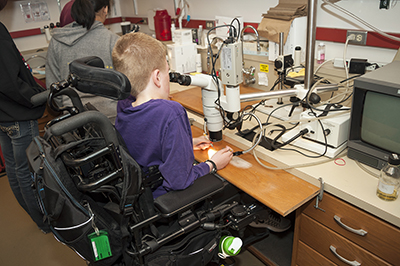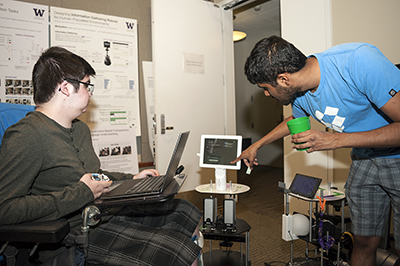Summer Study: What Do Phase II Scholars Do?
Phase II Scholars return to the UW Seattle campus for their second Summer Study. They meet the Phase I Scholars, learn about college life and career preparation, and participate in a one-week workshop with postsecondary instructors.
Neurobiology Workshop

In the Phase II Neurobiology lab, the Scholars focused on how drugs affected a mouse heart and the reaction cockroach leg spines had to different forms of stimulation. The Scholars involved in this lab were Jonah, Brookelyn, Aspen, Grady, and Chana. They gave embryonic mouse hearts caffeine and Sudafed. Both of these substances were meant to increase heart rate. The goal was to see which substance excited the heart more. The Scholars also bent the cockroach leg spines in different directions and even played music in an effort to see how the musical vibrations would affect the nerve reactions.
The Scholars learned a great deal in a week. Katelyn said she “learned about how electricity flows in the neurons.” Jonah learned that “each neuron has a different amplitude, which is the height of the wave that represented the reaction of the nerves.” Chana thought that she “learned a lot about axons and how they work.” The Scholars enjoyed the lab. According to Jonah, “[They] had great teachers.” The names of these teachers were Marti, Lauren, Comron, Kelly, Josh, Chris, and Curtis. The interns involved assisted by asking questions and moving the Scholars’ thoughts along.
Robotics Workshop

Greetings DO-IT Scholars! Welcome to Human Centered Robotics at the University of Washington. In this workshop, six Phase II Scholars learned how to use Python to program a robot to perform specific tasks.
Katie’s robot was named Khan and was programmed to assist with math tutoring. Max’s robot, Loerer, was programmed to teach languages. Laszlo’s robot, Ultravax, acted as a nurse to administer medication, and Andrew’s robot, called F.R.E.D. (French Robot Experimenting Device), was programmed to clean. Eli’s robot, Sport, provided information about sports, and Hailey’s robot, Walker, was programmed to walk a dog.
The Scholars started out by making a list of all the things they would like to do. Next, they talked about the different things each robot could be modified to do. Then they began programming the robots to do the tasks assigned. There were many changes they had to make to their program so that the robot would run.
Our Phase II Scholars learned how to teach new tricks to old robots. The sample robots were called TurtleBots, moving devices that are attached to advanced technologies like iPads and radios. They are connected to a wireless network called “CSE-Local.” Thanks to this network, the Scholars were able to program the robots through their computers. However, these tasks were difficult because computer code is usually complex.
The part that we (the Interns) liked best was brainstorming before projects. The Phase II Scholars used creative skills and functions to improve robots’ roles. Their coding was not always perfect — sometimes the code made the robots go in the wrong direction.
The Scholars learned four important steps in Human Centered Robotics: First, create ideas in coding and designing. Second, make the code in Python. Third, test the robots multiple times. Finally, let the robots perform the perfect code. Everyone, including the Interns, learned a lot from this experience.